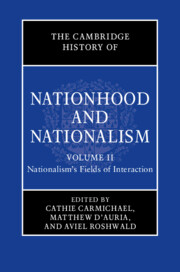Book contents
- The Cambridge History of Nationhood and Nationalism
- The Cambridge History of Nationhood and Nationalism
- The Cambridge History of Nationhood and Nationalism
- Copyright page
- Contents
- Figures
- Tables
- Contributors
- Part I Imperial and Postcolonial Settings
- 1 Building Nation-Empires in the Eighteenth-Century Iberian Atlantic
- 2 Nations and Nationalisms in the Late Ottoman Empire
- 3 The Dutch Empire
- 4 The Habsburg Monarchy
- 5 The British Empire
- 6 The French Empire
- 7 Germany as a “Global Nation,” 1840–1930
- 8 The Russian and Soviet Empire
- 9 The Japanese Empire
- 10 American Internationalism
- 11 The Indian Subcontinent: From Raj to Partition
- 12 Middle Eastern and North African Nationalisms
- 13 African Nationalisms
- 14 Bringing Empires Back in: The Imperial Origins of Nations in Indochina
- Conclusion to Part I
- Part II Transnational and Religious Missions and Identities
- Part III Intersections: National(ist) Synergies and Tensions with Other Social, Economic, Political, and Cultural Categories, Identities, and Practices
- Index
- References
1 - Building Nation-Empires in the Eighteenth-Century Iberian Atlantic
from Part I - Imperial and Postcolonial Settings
Published online by Cambridge University Press: 08 November 2023
- The Cambridge History of Nationhood and Nationalism
- The Cambridge History of Nationhood and Nationalism
- The Cambridge History of Nationhood and Nationalism
- Copyright page
- Contents
- Figures
- Tables
- Contributors
- Part I Imperial and Postcolonial Settings
- 1 Building Nation-Empires in the Eighteenth-Century Iberian Atlantic
- 2 Nations and Nationalisms in the Late Ottoman Empire
- 3 The Dutch Empire
- 4 The Habsburg Monarchy
- 5 The British Empire
- 6 The French Empire
- 7 Germany as a “Global Nation,” 1840–1930
- 8 The Russian and Soviet Empire
- 9 The Japanese Empire
- 10 American Internationalism
- 11 The Indian Subcontinent: From Raj to Partition
- 12 Middle Eastern and North African Nationalisms
- 13 African Nationalisms
- 14 Bringing Empires Back in: The Imperial Origins of Nations in Indochina
- Conclusion to Part I
- Part II Transnational and Religious Missions and Identities
- Part III Intersections: National(ist) Synergies and Tensions with Other Social, Economic, Political, and Cultural Categories, Identities, and Practices
- Index
- References
Summary
On 19 March 1812, after much deliberation, the Spanish parliament, the Cortes, promulgated Spain’s first written constitution, the celebrated Constitution of Cádiz.1 Seen in the context of the Age of Revolutions, a time when political revolutions in the Thirteen Colonies, France, and Haiti were accompanied by written constitutions, the 1812 Constitution of Cádiz was not exactly at the vanguard of the Atlantic world. Nonetheless, the importance and peculiarity of this constitution lay not in the content or nature of the document but in who was involved in its design. The constitution of the United States of America, the many French constitutions during the revolutionary period, and the various Haitian constitutions written beginning in 1801 were primarily a product of one hemisphere or the other, but not both. In contrast, Spain’s Constitution of 1812 came about as a result of an imperial parliament with deputies representing the multiplicity of territories of Spain’s oceanic empire.
- Type
- Chapter
- Information
- The Cambridge History of Nationhood and Nationalism , pp. 3 - 23Publisher: Cambridge University PressPrint publication year: 2023

